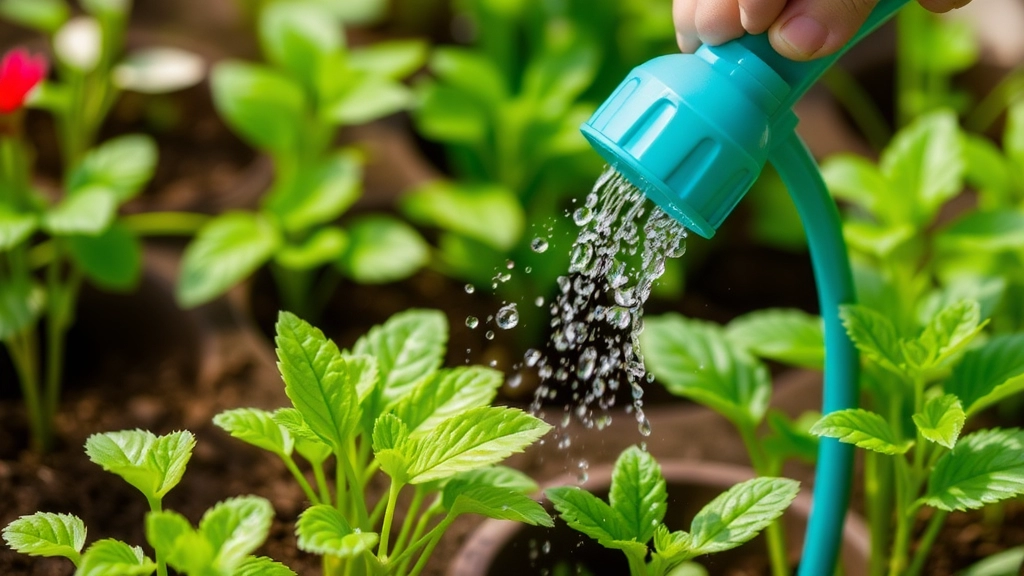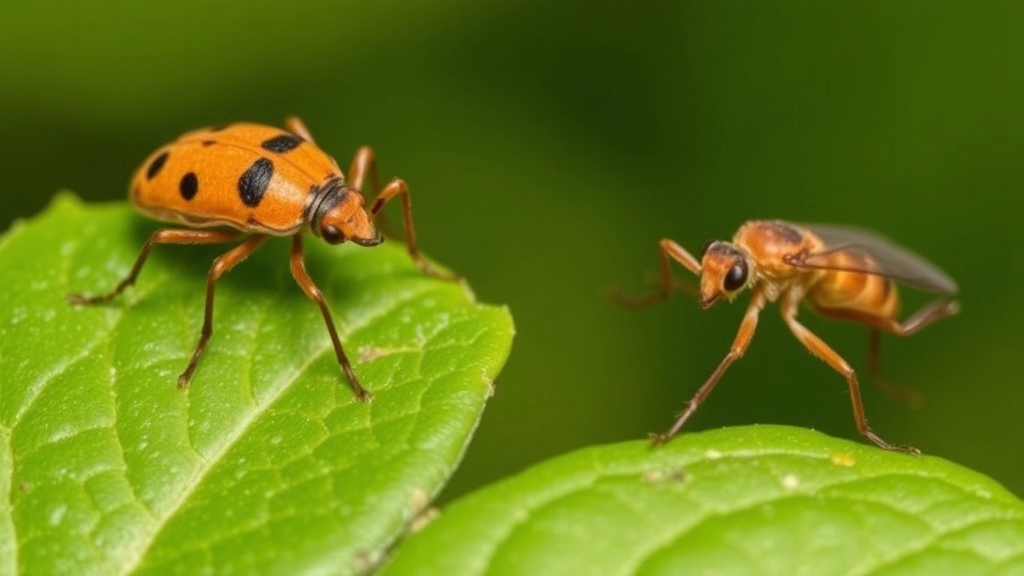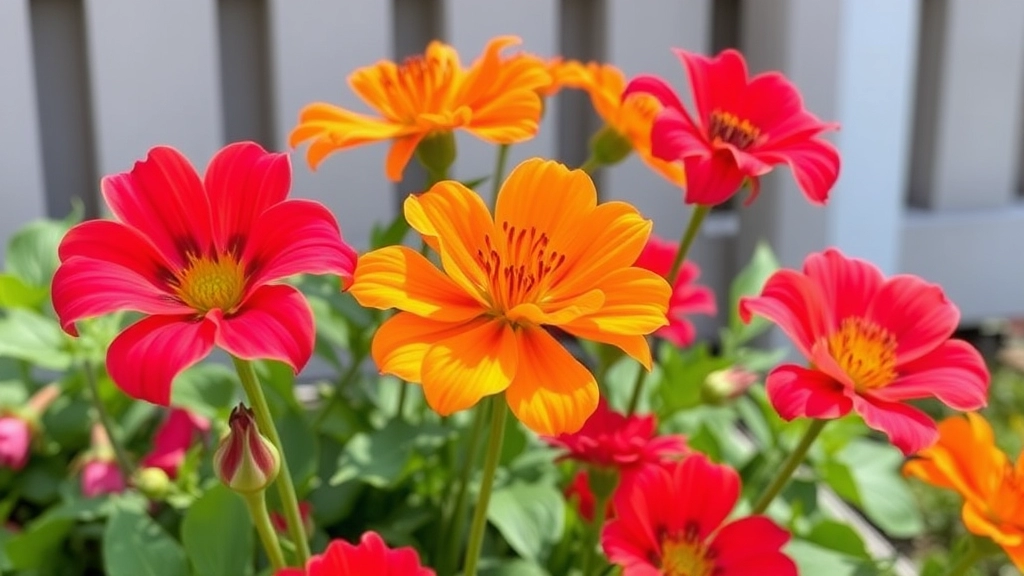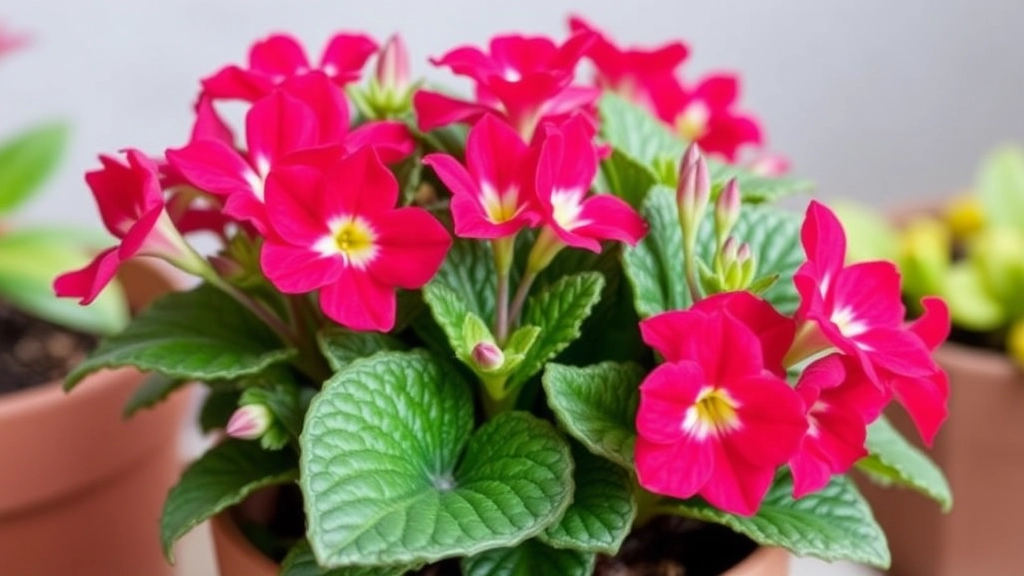Kalanchoe Flaming Katy Houseplant
If you’re looking to add a splash of vibrant colour to your indoor garden, the Kalanchoe Flaming Katy houseplant is a perfect choice. This stunning succulent, scientifically known as Kalanchoe blossfeldiana, not only brightens up any space with its vivid blooms but is also relatively easy to care for. Whether you’re a seasoned plant enthusiast or a newbie, understanding the best light conditions, watering tips, and soil requirements can help you keep your Flaming Katy thriving.
To ensure your Flaming Katy remains healthy and blooms beautifully, it’s crucial to get the basics right. From the ideal lighting and watering schedule to proper fertilization and pest control, this guide covers everything you need to know. Let’s dive into the essentials of caring for your Kalanchoe Flaming Katy houseplant, so you can enjoy its cheerful flowers all year round.
Best Light Conditions for Flaming Katy
Are you struggling to keep your Flaming Katy thriving?
Light conditions play a crucial role in the health and vibrancy of your plant.
Optimal Light Exposure
Flaming Katy, also known as Kalanchoe blossfeldiana, flourishes in bright, indirect sunlight. Here’s what you need to keep in mind:
- Direct Sunlight: Too much direct sunlight can scorch the leaves. Aim for a spot where the sunlight is filtered.
- Duration: Ideally, your plant should receive around 6 hours of light daily. Morning sun is particularly beneficial.
- Indoor Placement: If you’re keeping your Flaming Katy indoors, a south-facing window is perfect. It provides ample light without the harsh midday rays.
Signs of Insufficient Light
If your plant isn’t getting enough light, you might notice:
- Leggy Growth: Stretched stems reaching for light.
- Faded Leaves: A loss of vibrant colour.
Adjusting Light Conditions
If your Flaming Katy shows these signs, consider moving it closer to a light source or supplementing with grow lights. For more detailed care tips, check out this complete care guide for Kalanchoe Flaming Katy.
Additionally, if you’re curious about the best lighting tips for other Kalanchoe varieties, you might find this article on whether Kalanchoe can take full sun particularly useful.
Watering Tips for Healthy Growth

Are you worried about overwatering your Flaming Katy? Or maybe you’re unsure how often to give it a drink? You’re not alone! Many plant lovers face these common concerns.
Finding the Right Balance
Watering is crucial for the health of your Flaming Katy, but it’s all about balance. Here are some easy tips to keep your plant thriving:
- Check the Soil: Before watering, stick your finger about an inch into the soil. If it feels dry, it’s time to water. If it’s still moist, hold off for a bit.
- Water Deeply: When you do water, give it a good soak. Aim for the roots, ensuring the water drains out of the bottom. This encourages deep root growth.
- Frequency: Generally, you’ll want to water every 2-3 weeks. However, this can change with the seasons. In summer, you might need to water more often, while in winter, less is best.
- Avoid Waterlogging: Flaming Katy is a succulent, so it doesn’t like sitting in water. Make sure your pot has drainage holes to prevent root rot.
Signs of Over or Underwatering
Keep an eye out for these signs:
- Overwatering: Yellowing leaves or mushy stems can indicate too much water.
- Underwatering: Wrinkled or shrivelling leaves mean your plant is thirsty.
By keeping these tips in mind, you can ensure your Flaming Katy stays healthy and vibrant.
Soil Requirements for Optimal Growth
When it comes to nurturing your Flaming Katy, the right soil is essential for ensuring vibrant blooms and healthy growth. You might be wondering, “What type of soil does my plant need?” Let’s break it down.
Ideal Soil Composition
Flaming Katy, also known as Kalanchoe blossfeldiana, thrives in well-draining soil. Here are the key components to consider:
- Cactus Mix: A commercial cactus mix is often ideal due to its excellent drainage properties.
- Perlite or Pumice: Adding these materials can enhance aeration and drainage.
- Organic Matter: Incorporate some organic matter like compost to provide essential nutrients.
pH Level
The pH level of the soil is another factor to consider. Flaming Katy prefers slightly acidic to neutral soil, ideally between 6.0 and 7.0.
- Testing Soil pH: Use a simple pH test kit to check your soil’s acidity. Adjust as needed with lime to raise pH or sulfur to lower it.
Container Considerations
If you’re growing Flaming Katy in pots, choose containers with drainage holes to prevent water accumulation.
- Terracotta Pots: These are excellent as they allow moisture to evaporate quickly, helping to maintain the right soil conditions.
Soil Maintenance Tips
Maintaining the right soil conditions is crucial for the health of your Flaming Katy. Here are some quick tips:
- Repotting: Consider repotting every couple of years to refresh the soil and provide new nutrients.
- Soil Drainage: Always ensure that excess water can escape. If the soil feels compacted, it may be time for a change.
For more detailed information on how to care for your Kalanchoe, check out our Comprehensive Kalanchoe Plant Care Guide. If you’re interested in other varieties, you might find our guide on Top Flowering Kalanchoe Species and Care Tips helpful.
Temperature and Humidity for Flaming Katy

When caring for your Flaming Katy, understanding the ideal temperature and humidity levels is crucial for its health and blooming potential. You might be wondering, “What temperature does my Flaming Katy need?” or “How humid should the environment be for optimal growth?”
Ideal Temperature Range
Flaming Katy, or Kalanchoe blossfeldiana, thrives best in a warm environment. Here are some key points to consider:
- Daytime Temperature: Aim for 20°C to 25°C (68°F to 77°F).
- Nighttime Temperature: A slight drop to around 15°C to 18°C (59°F to 65°F) is ideal.
- Avoid Extremes: Temperatures below 10°C (50°F) can stress the plant, leading to poor growth.
Humidity Levels
Humidity plays a vital role in the overall wellbeing of Flaming Katy. Here’s what you should know:
- Optimal Humidity: Keep humidity levels between 40% to 60%.
- Avoid High Humidity: Excess moisture can lead to fungal issues and root rot.
- Dry Environments: If you live in a dry area, consider using a pebble tray or a humidifier to maintain adequate moisture.
Tips for Maintaining Temperature and Humidity
- Location Matters: Place your Flaming Katy in a spot where it receives indirect sunlight, away from drafts or heat sources.
- Monitor Conditions: Use a thermometer and hygrometer to keep an eye on temperature and humidity levels.
- Seasonal Adjustments: In winter, ensure that your plant is not too close to heating vents.
Fertilization Schedule for Prolonged Blooming
Are you wondering how to keep your Flaming Katy blooming beautifully throughout the year?
Proper fertilization is key to achieving vibrant flowers and healthy growth.
Common Pests and Diseases to Watch For

So, you’ve got your Flaming Katy thriving, but what about those pesky pests and sneaky diseases that can ruin your hard work?
Let’s dive into the common culprits that could threaten your beautiful blooms:
1. Mealybugs
- These little white fluffballs love to hide in the leaf joints.
- They suck the sap out of your plant, leading to yellowing leaves.
- Tip: Wipe them off with a cotton swab dipped in rubbing alcohol.
2. Aphids
- Tiny and often green, these guys can multiply quickly.
- They also suck sap and can cause stunted growth.
- Tip: Spray your plant with a strong jet of water to dislodge them.
3. Spider Mites
- You might not see them right away, but look for fine webbing on your plant.
- They thrive in dry conditions and can cause leaf drop.
- Tip: Increase humidity and use insecticidal soap to tackle them.
4. Root Rot
- This isn’t a pest, but it’s a disease to be wary of.
- Overwatering is the main culprit, leading to mushy roots.
- Tip: Always ensure your pot has drainage holes and let the soil dry out between waterings.
5. Fungal Infections
- Look out for spots on leaves or a powdery coating.
- These can develop in overly humid conditions.
- Tip: Ensure good air circulation and avoid wetting the leaves during watering.
Keeping an eye on these pests and diseases can save your Flaming Katy from a lot of heartache.
Pruning and Deadheading for Fuller Blooms
Maintaining the vibrant blooms of your Flaming Katy (Kalanchoe blossfeldiana) is essential for a flourishing display.
Many enthusiasts wonder how to achieve fuller and more abundant flowers.
Pruning and deadheading are key techniques that can significantly enhance your plant’s performance.
Why Prune and Deadhead?
- Encourages Growth: Regular pruning stimulates new growth, leading to more blooms.
- Removes Dead Flowers: Deadheading prevents the plant from wasting energy on fading flowers, allowing it to focus on producing new ones.
- Prevents Disease: Removing dead or damaged leaves can help reduce the risk of pests and diseases.
How to Prune Flaming Katy
- Timing: Prune in early spring, just before the growing season.
- Tools: Use clean, sharp scissors or pruning shears to avoid injury to the plant.
- Technique:
- Remove any dead or yellowing leaves.
- Cut back leggy stems to encourage bushier growth.
- Trim spent flowers just above the leaf node.
Deadheading Tips
- Frequency: Check your plant weekly for spent blooms.
- Method: Pinch or cut the flower stem just above the first set of leaves.
By implementing these simple yet effective practices, you can ensure that your Flaming Katy remains vibrant and full of life. For more detailed care instructions, you can refer to the Comprehensive Kalanchoe Plant Care Guide. Additionally, if you are experiencing issues with your plant not flowering, our article on Why Your Kalanchoe Isn’t Flowering: Causes and Solutions might be helpful.
How to Propagate Flaming Katy Easily

So, you’ve got a lovely Flaming Katy (Kalanchoe blossfeldiana) and you’re wondering how to make more of these beauties?
Propagation is easier than you might think!
Here’s a straightforward guide to help you get started:
- Choose the Right Time: Spring is the best season for propagation. The warmer weather encourages growth.
- Select Healthy Leaves or Stems: Look for plump, healthy leaves or stems on your Flaming Katy. Avoid any that look wilted or damaged.
- Cut and Dry: Use a clean, sharp knife to cut a leaf or stem. Let it sit for a couple of days in a dry place. This helps form a callus, which reduces the risk of rot.
- Prepare Your Soil: Use a well-draining soil mix, preferably one made for succulents. You want it light and airy.
- Planting: Once the cuttings have callused over, plant them in the soil. Make sure they’re not too deep—just enough to stay upright.
- Water Sparingly: After planting, wait about a week before watering. Then, give them a light misting. Too much water can lead to root rot.
- Provide Bright Light: Place your cuttings in a spot with plenty of indirect sunlight. Direct sunlight can scorch them.
- Patience is Key: It might take a few weeks for roots to develop, but don’t rush it. Just keep an eye on them!
Once your cuttings have rooted, you’ll have new Flaming Katy plants to enjoy or share with friends.
Preventing Root Rot in Succulents
Root rot is a common concern for succulent enthusiasts, particularly for those nurturing Flaming Katy.
Why Does Root Rot Happen?
Root rot occurs when the roots sit in waterlogged soil, leading to decay. Here are some key reasons:
- Overwatering: This is the leading cause. Succulents thrive in dry conditions.
- Poor drainage: Soil that retains too much moisture can suffocate roots.
- Humidity: High humidity levels can exacerbate moisture retention.
How to Prevent Root Rot
To keep your Flaming Katy thriving, consider these straightforward tips:
- Choose the Right Pot:
- Use pots with drainage holes to allow excess water to escape.
- Select Appropriate Soil:
- Opt for a well-draining cactus or succulent mix.
- You can even add perlite or sand to improve drainage.
- Water Wisely:
- Allow the soil to dry out completely between watering sessions.
- Water deeply but infrequently, ensuring excess water drains away.
- Monitor Humidity Levels:
- Keep your plants in a location with good airflow.
- Avoid overly humid environments, especially indoors.
- Inspect Regularly:
- Check the roots if you notice wilting or yellowing leaves.
- Trim away any mushy or discoloured roots to prevent the spread.
By following these tips, you can significantly reduce the risk of root rot and ensure your Flaming Katy remains healthy and vibrant. For more detailed care instructions, you can refer to our complete guide on caring for Kalanchoe after flowering and how to treat and prevent Kalanchoe leaf spot.
How to Encourage Re-blooming in Flaming Katy

So, you’ve got your Flaming Katy all settled in, and now you’re itching to see those vibrant blooms again. It’s a common concern among plant lovers—how can you coax those beautiful flowers to return? Don’t worry; I’ve got some straightforward tips that will help you get your plant blooming again.
1. Light It Up!
Flaming Katy thrives in bright, indirect sunlight. If your plant is looking a bit lackluster, consider moving it to a sunnier spot. Just keep an eye on it; too much direct sunlight can scorch those lovely leaves.
2. Water Wisely
Overwatering is a sneaky culprit when it comes to re-blooming. Make sure the soil dries out completely between waterings. A good rule of thumb? Water when the top inch feels dry.
3. Prune for Growth
After the blooming period, don’t just sit back! Snip away any dead flowers and leaves. This not only tidies up your plant but encourages new growth, which can lead to more blooms.
4. Feed the Right Way
Use a balanced, water-soluble fertiliser every few weeks during the growing season. This gives your Flaming Katy the nutrients it needs to produce those stunning flowers.
5. Give It a Rest
Sometimes, plants need a break. Allow your Flaming Katy to have a resting period after blooming. Cut back on watering and fertilising for a month or two. It’s like a little holiday for your plant!
6. Watch the Temperature
Keep your Flaming Katy in a spot where temperatures are between 18°C and 24°C. Sudden temperature drops or drafts can stress your plant, making it less likely to bloom.
7. Patience is Key
Don’t forget—sometimes, it just takes a bit of time. With the right conditions, your Flaming Katy will reward you with another round of blooms.
Decorative Uses and Companion Plants for Flaming Katy
Are you looking to enhance your indoor or outdoor space with the vibrant colours of Flaming Katy?
This stunning succulent not only adds a pop of colour but also pairs beautifully with various plants and decor styles.
Decorative Uses of Flaming Katy
- Indoor Displays:
- Place Flaming Katy on windowsills or coffee tables for a lively touch.
- Group them in clusters for a more dynamic visual impact.
- Outdoor Gardens:
- Use Flaming Katy in rock gardens or succulent arrangements.
- They thrive in containers, making them perfect for patios or balconies.
- Floral Arrangements:
- Incorporate Flaming Katy in mixed bouquets for a unique twist.
- Their long-lasting blooms make them ideal for cut flower displays.
Companion Plants for Flaming Katy
Choosing the right companion plants can elevate the beauty of your Flaming Katy. Here are some excellent options:
- Aloe Vera:
- Both are low-maintenance and thrive in similar conditions.
- Sedum:
- Their diverse textures and colours complement Flaming Katy beautifully.
- Echeveria:
- These rosette-shaped succulents provide a lovely contrast to Flaming Katy’s blooms.
- Hens and Chicks (Sempervivum):
- Their hardy nature and varied colours make for an interesting mix.
- Cacti:
- Pairing with cacti creates a stunning desert-themed display.
When selecting companion plants, consider their light and water needs to ensure they thrive together.
Incorporating Flaming Katy into your decor not only brightens your space but also allows for creative plant combinations. For more details on how to care for this vibrant succulent, check out our Flaming Katy care guide. If you’re interested in other Kalanchoe varieties, our guide on Kalanchoe succulents with red flowers might be helpful.
FAQs about Flaming Katy (Kalanchoe blossfeldiana) Houseplant
How often should I water my Flaming Katy?
Generally, you should water your Flaming Katy every 2-3 weeks. However, this can vary with the seasons. In summer, you might need to water more often, while in winter, less is best. Always check the soil moisture before watering.
What are the signs of overwatering or underwatering?
Overwatering can cause yellowing leaves or mushy stems, while underwatering often results in wrinkled or shrivelling leaves. Adjust your watering schedule accordingly if you notice these signs.
What is the ideal temperature range for Flaming Katy?
Flaming Katy thrives best in a warm environment. Aim for daytime temperatures between 20°C to 25°C (68°F to 77°F) and nighttime temperatures around 15°C to 18°C (59°F to 65°F). Avoid temperatures below 10°C (50°F).
How can I maintain the right humidity level for my Flaming Katy?
Keep humidity levels between 40% to 60%. If you live in a dry area, consider using a pebble tray or a humidifier to maintain adequate moisture. Avoid high humidity to prevent fungal issues.
What pests and diseases should I watch out for?
Common pests include mealybugs, aphids, and spider mites. Diseases to watch for include root rot and fungal infections. Regularly inspect your plant and take action at the first sign of trouble.
How do I propagate my Flaming Katy?
Spring is the best time for propagation. Select healthy leaves or stems, let them dry for a couple of days to form a callus, and then plant them in well-draining soil. Water sparingly and provide bright, indirect light.
How can I encourage my Flaming Katy to re-bloom?
Ensure your plant gets bright, indirect sunlight, and allow the soil to dry out between waterings. Prune dead flowers and leaves, use a balanced fertilizer during the growing season, and give the plant a resting period after blooming.
What should I do if my Flaming Katy’s leaves are turning yellow?
Yellow leaves can be a sign of overwatering. Check the soil moisture and ensure your pot has good drainage. Adjust your watering schedule to let the soil dry out more between waterings.
Can I keep my Flaming Katy outdoors?
Flaming Katy can be kept outdoors in warm climates, but it should be protected from direct sunlight and extreme temperatures. Ensure it is in a spot with indirect sunlight and monitor the temperature closely.
Why are my Flaming Katy’s leaves wrinkling?
Wrinkled leaves are usually a sign of underwatering. Check the soil moisture and water your plant if the top inch of soil feels dry. Make sure to water deeply but avoid waterlogging.
References
-
The Spruce: Kalanchoe Plant Profile
-
Gardening Know How: Kalanchoe Plant Care
-
Houseplant411: Kalanchoe Plant Care Guide
